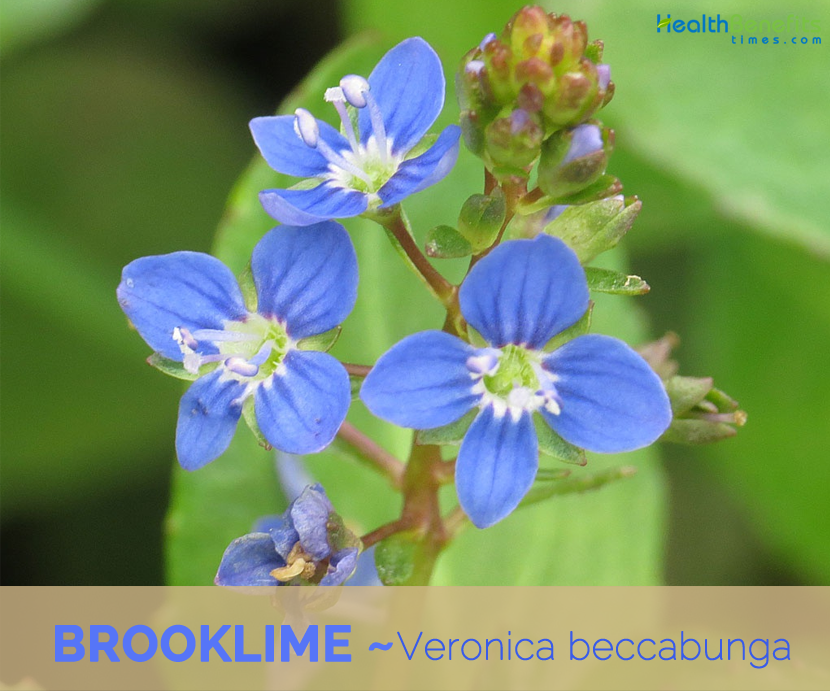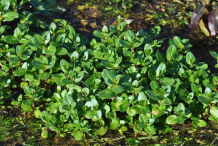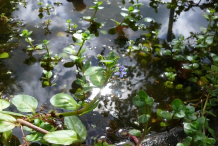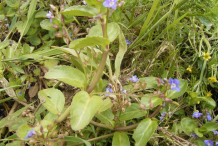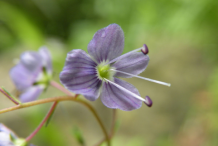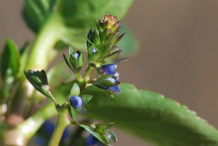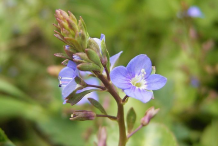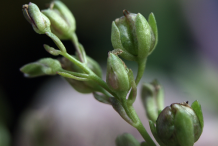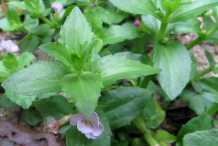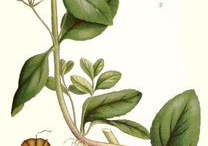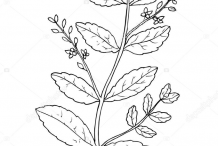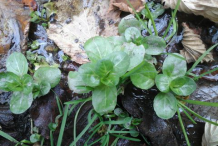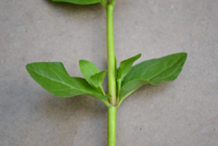| Brooklime Quick Facts |
| Name: |
Brooklime |
| Scientific Name: |
Veronica beccabunga |
| Origin |
Almost all of Europe, western and northern Asia and northern Africa |
| Colors |
Brown |
| Shapes |
Spherical, with shallowly notched tip, 2.5–4 mm (0.1–0.16 in.) long, glabrous, capsule |
| Taste |
Pungent |
| Health benefits |
Helpful in treating Skin Disorders, Scurvy, cough, loss of appetite, constipation, dysentery, liver ailments and hemorrhoids. |
Brooklime is botanically known as Veronica beccabunga and the herb belongs to the Scrophulariaceae family. Other common names of this herb include European Brooklime, Cow Cress, Becky Leaves, Limewort, Water Pimpernel, water pumpy, well-ink, horse cress, limewort, limpwort and becky leaves. The plant grows on the margins of brooks and ditches in Europe, North Africa and north and western Asia. It can be found on other continents as an introduced species. Brooklime is a common sight in the UK where it can be seen in the Shetlands and the Wetlands. The term beccabunga has been derived from the German word Bachbunge and it means – a brook and a bunch. Brooklime is commonly seen along the brooks or streams. The medicinal parts are the fresh flowering plant freed from the root, the fresh aerial parts collected during the flowering season and the whole plant.
Plant Description
Brooklime is an evergreen, aquatic perennial herb that grows about 20–60 cm (8–25 in.) tall. The plant is found growing in most wetland types; it is most typical on the margins of rivers and streams, even in temporary springs in the headwaters (such as winterbournes). It also occur in the draw-down zones of lakes and ponds and in ditches and canals either where water is relatively shallow or the bank slopes are gentle enough to allow it to root in the margins. It is also not uncommon on wet rides in woodland. It also grows in and near streams and ditches with slow running water, wet pasture and other areas with continuous moisture. The plant has a creeping rhizome. Stem is ascending, up to 50 cm high, round and filled with latex. Leaves are oval-oblong, smooth, about 1 1/2 inch long, slightly toothed on their margin and thick and leathery in texture. The whole plant is very smooth and shiny in appearance, turning blackish in drying.
Flower & Fruit
The flowers are in loose, axillary, diagonal clusters. The accompanying leaves are linear, as long as or shorter than the flowers. The peduncles and pedicles are glabrous. The calyx is dorsiventral and divided into 4. The sepals are lanceolate to spatulate and acuminate; the front ones are larger than the back ones. The corolla is rotate with a very short tube, 4 to 9 mm wide and bright blue, with darker veins and a white eye, the petals oval and unequal. Occasionally a pink form is found. The ovary is green and the stigma capitual-like. They begin to open in May and continue in series through the greater part of the summer, though are at their best in May and June. The fruit is a 2.5–4 mm (0.1–0.16 in.) long, glabrous, cordate, almost globular, narrow-winged capsule. The seeds are 0.6 mm long and 0.45 mm wide, winged and flattened. They are yellow, oval and flatly convex with a fairly smooth back.
Health Benefits of Brooklime
Although the medicinal value of the brooklime plant is not very significant, the whole plant is useful for restoring normal health. The plant helps to protects against scurvy; reduces high fever; emenagogue; slightly diuretic increasing the outflow of urine. In addition, when the plant is added to meals, it functions as a purgative. The following are the few of the health benefits of Brooklime
1. Skin Disorders
The herb was used to treat gout and swellings in other parts of the body during 14th century. Some suggest that the leaves of the herb can also be applied to the skin to treat wounds, burns, sores, atopic eczema, boils, rashes and whitlows (an infection of the toe and fingers).
2. Scurvy
Brooklime is popularly associated with the treatment of Scurvy, which is caused due to the deficiency of Vitamin C in the body. In early times, a particular infusion known as the spring juice was made to treat Scurvy using the juices of Brooklime, scurvy grass and seville orange.
Even today, the antiscorbutic properties of the herb are valued in folk medicine. Brooklime is also mentioned in the Pharmacopoeia of England as a possible cure for scurvy.
3. Other Benefits
Brooklime is also associated with the treatment of liver problems, blood impurity, high fever, low urine production and painful urination, Scrofula, cold, cough, constipation and hemorrhoids. Frequent use of brooklime in your daily schedule is quite beneficial to get all these benefits.
https://www.youtube.com/watch?v=xC9TLGiyiY0
Traditional uses and benefits of Brooklime
- In earlier days the leaves were applied to wounds.
- They are sometimes bruised and put on burns.
- An infusion of the leaves is recommended for impurity of the blood, an ounce of them being infused in a pint of boiling water.
- Brooklime was used for many complaints, including swellings, gout, etc. during fourteenth century.
- Herb was mentioned in the Pharmacopoeia of England and was recommended as an herbal remedy to treat scurvy and Scrofula, a form of tuberculous infection of the lymph nodes mostly in the neck.
- Brooklime was used in folk medicine as an herb to ease painful urination, to treat respiratory ailments such as colds and cough, for loss of appetite, constipation, dysentery, liver ailments and hemorrhoids.
- It has been used traditionally to treat atopic eczema, rashes, boils, burns and wounds.
- Whole plant is alterative, antiscorbutic, very mildly diuretic, emenagogue and febrifuge.
- It is of little benefit as a medicinal herb, but has a beneficial laxative effect when included in the diet.
- Leaves are used in the treatment of scurvy, impurity of the blood etc.
- Plant is bruised and applied externally as a politic on burns, ulcers, whitlows, etc.
- Herb is used as an alternative medicine and protects against scurvy, reduces high fever and is emenagogue as well as slightly diuretic increasing the outflow of urine.
- Additionally, when this herb is added to meals, it functions as a purgative.
- Herbalists often prescribe the herb to heal scurvy (a disease caused by shortage of vitamin C) and also to cleanse the blood.
- Herb is pounded and made into a poultice to apply externally to heal sores, burns, whitlows (infectivity of the toe and fingers) and other similar problems.
- Although the brooklime plant’s ability to stop bleeding is not significant, in earlier times, herbal medical practitioners used the herb to heal open wounds.
- It is also used for constipation, liver complaints, dysentery and lung conditions.
- Drug has been reported to be effective against bleeding of the gums.
Ayurvedic Health benefits of brooklime
- Skin: Apply the fresh juice to get relief in chronic skin diseases.
- Gout: Drink the fresh juice of Speedwell 3-4 times a day.
- Sore Throat: Steep 2 tbsp herb in half cup of boiling water for 10 minutes. Gargle with this lukewarm water 2-3 times a day.
- Eczema: Pick the flowering tops of the herb and make a tea. Use as a wash for eczema and other skin diseases.
- Expectorant: Boil the flowering tops of speedwell in some water to make a tea. Drink hot twice a day.
Culinary Uses
- Dried herb can be used as an herbal tea, usually with other herbs.
- Raw leaves of the herb may be mixed with salads or with watercress, another partially aquatic plant that is used as salads, in soups and for garnishing.
- Leaves of the brooklime plant may also be cooked with along other tasty and aromatic green leafy vegetables.
References:
https://www.itis.gov/servlet/SingleRpt/SingleRpt?search_topic=TSN&search_value=33412#null
https://www.cabi.org/isc/datasheet/117805
https://www.botanical.com/botanical/mgmh/b/brookl69.html
http://www.floracatalana.net/veronica-beccabunga-l
https://plants.usda.gov/core/profile?symbol=vebe
http://www.theplantlist.org/tpl1.1/record/kew-2454060
https://www.pfaf.org/USER/Plant.aspx?LatinName=Veronica+beccabunga
https://en.wikipedia.org/wiki/Veronica_beccabunga
Comments
comments


